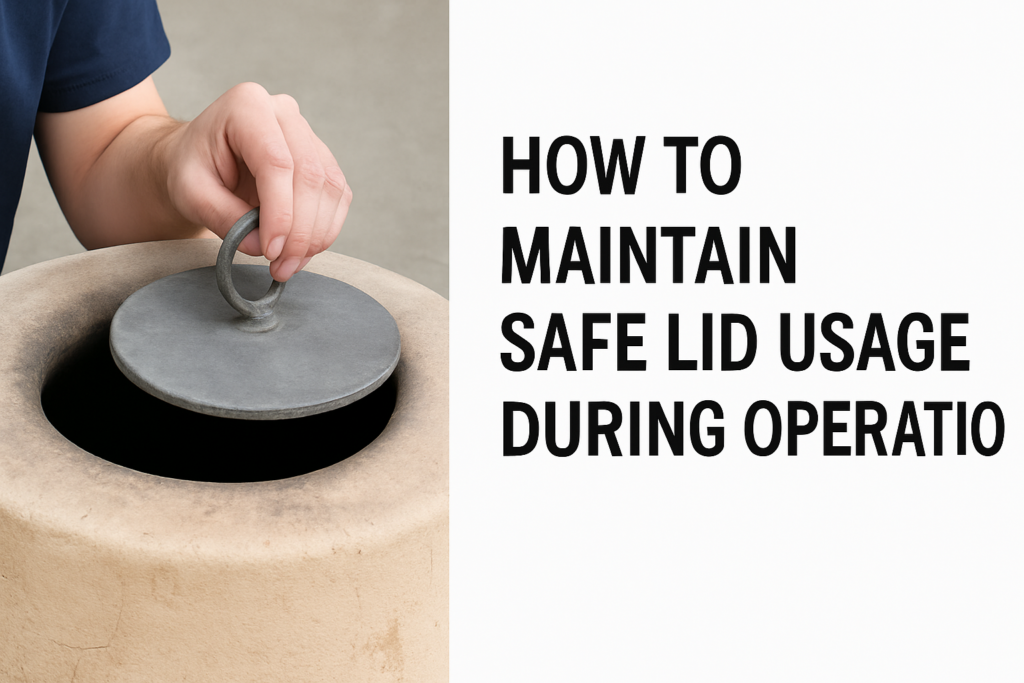How to Maintain Safe Lid Usage During Operation
Learning safe tandoor operation protects equipment and the person handling it from serious harm. In addition, it guarantees lesser toxic gases and pollution and lesser chances of burns, fires, and structural failures. In this regard, it is worth noting that Maintaining lid safety—knowing when to open, close, and partially cover boosts cooking performance while preventing flare-ups, gas hazards, heat damage, and burn injuries.

Tandoor lid safety approach to follow
Here is the Tandoor lid safety approach to maintain when operating a tandoor:
- Heating and Startup
Remove lids completely until initial flames subside and walls reach the proper temperature.
Allow the open mouth to vent smoke and flare-ups.
Open ash vents or small doors for controlled airflow.
- Cooking
Place lids only after the flames have died down and you notice that the interior walls have turned white. In this regard, it’s worth noting that a closed lid helps retain heat for more, even cooking while limiting air to avoid flare-ups.
For handling, use heat-resistant gloves or tongs to handle a hot lid safely.
- Safety Tips Throughout Operation
Never cover lids while flames are visible, as that’s responsible for overheating gas valves or cracking the clay.
Use protective gloves when handling lids or skewers.
Also, ensure to keep the lid partially open to maintain airflow and avoid pressure building inside.
- Shutdown and Cooling
Once cooking finishes, turn off the fuel. Follow with fully closing lids to smother any remaining embers. The approach is beneficial in extinguishing coals gradually without adding water, protecting the clay.
However, note that you never use water for quenching, and let the tandoor cool naturally.
Tips to follow for Safe tandoor operation
Let’s discuss the comprehensive guide to safe tandoor operation, covering setup, operation, and shutdown.
- Proper Setup and Placement
Choose a non-flammable surface that lacks movement. Also, ensure that it’s away from wood or similar inflammable structures.
Enough ventilation is a must, especially for indoor gas tandoors. A certified hood guarantees adequate airflow.
Ensure that there are secure connections. For that, it’s advisable to tie down the unit if mobile and use certified, flexible gas hoses. Also, conduct tests for leaks daily with soapy water.
- Lighting and Initial Heat-Up
Use appropriate fuel from the recommended ones like charcoal, hardwood, or approved gas. But make sure to avoid lighter fluids or accelerants.
Start a small fire by gradually increasing heat to allow the clay to expand slowly, as that’s what helps to prevent thermal shock and cracking.
Remove lids and vents initially until you notice that the walls are evenly heated and the flames stabilize.
- Cooking Phase
Wear protective clothing, including thick gloves, an apron, and closed-toe shoes. Also, for handling purposes, use long-handled tools.
Monitor lid position as a must for better safety. It’s highly recommended to close or partially close once flames settle to maintain heat. However, take care not to seal during the active flame phase. This is what helps prevent overpressure and component damage.
Control airflow in the process. Make sure to adjust vents or gas valves, as that’s what helps with maintaining temperature and reducing flare-ups.
Avoid overloading, and so for this, take care to leave space between skewers/bread for even cooking and reduce fire hazards.
- Safety and Monitoring
No matter what, constantly watch for sparks, smoke, or flare-ups. Ensure that you’re ready with a fire extinguisher or sand bucket handy in case of emergency.
Install CO detectors indoors as often improper charcoal use is responsible for the emission of dangerous carbon monoxide.
- Shutdown and Cleanup
Turn off the fuel and close vents/lids so that it can extinguish naturally; note that you should never use water.
Clean the interior regularly for high-end maintenance. Remove ash and debris. Also, gently brush clay walls and metal surfaces.
Inspect for cracks as well for the reason that deeper structural damage demands repair or replacement.
How to use tandoor lid
step-by-step guide on how to use the tandoor are as follows:
- Initial Warm-Up
Keep the lid fully off, allowing smoke and flames to escape and the clay to warm gradually.
Once you notice that the inner walls glow white, be ready to proceed.
- Adding fuel and reaching the cooking temperature
Continue burning with the lid off as you gradually add hardwood or charcoal, ensuring the fire stays below the neck.
Place the lid on only when you notice that the flames have completely subsided and there are red coals, as it helps retain heat for cooking.
- Cooking Phase
The lid helps the tandoor retain high internal heat.
Keep the lid fully closed while cooking; manage airflow on gas tandoors via built-in vents or valves, not the lid.
- Finishing Up and Cooling
After cooking, turn off the flame/fuel. Now, simply close the lid fully to facilitate safe, gradual cooling.
Tandoor cooking safety tips
Essential tandoor cooking safety tips to ensure a safe, enjoyable experience are as follows:
- Setup
Use a non-flammable surface, as already stated above, with the absence of inflammable. Using indoors isn’t recommended unless you have having certified gas or electric unit with proper ventilation.
- Initial Conditioning
Start with a small fire, and then go ahead gradually with adding fuel. Keep the lid off until the walls glow white. The method is impeccable to allow the clay to expand slowly.
- Protective Gear and Handling
Heat-resistant gloves and long-handled tools help a lot in handling the tandoor. Also, it’s advisable to avoid loose clothing or synthetic fabrics.
It’s advisable not to touch exterior walls reaching around 800 °C (1,472 °F).
- Cooking Operation
Never put the lid on when you notice the flames are active. It’s recommended to cover only after flame subsides and coals form.
Use vents or control gas valves that can assist with temperature control.
Also, it’s mandatory to note not to overload. Pay attention to leaving space between items for even cooking and reduced flare-ups.
- Fire Safety
Never leave a lit tandoor unattended, and that’s why it’s better to be ready with a fire extinguisher nearby.
For wood-fueled units, it’s highly recommended to use hardwood charcoal/
- Aftercare
While putting off the entire system, turn off the fuel, then close the lid and vents to let it cool naturally.
Never extinguish with water, as the use of water is enough to crack the ceramic.
After cooling, clean ash and debris and also mandatorily inspect for damage and store it dry or undercover.
Final words
Proper use of a lid, maintaining the safety standards, and following the overall best procedure for handling can be effective in increasing the longevity of a tandoor. In addition, consider purchasing the piece from a reputed brand like Tandoor Morni that can guarantee that the tandoor is long-lasting and effective for your purpose.
Need Help? Order and Technical Support
Have questions or ready to place an order? Reach out to us via phone at +1(727) 251 6924 or email us at info@tandoormorni.com. Need detailed instructions? Explore the Operation Manual for our CH & CS models to get started with your Tandoor oven today.
About Tandoor Morni
Tandoor Morni, in business since 1992, is a trusted name in premium Tandoori Clay Ovens, known for crafting high-quality traditional and commercial tandoors. With a commitment to excellence, Tandoor Morni offers a wide range of tandoors, including commercial, residential, catering, and copper models. Our tandoors are built with durable materials and designed for efficient heat distribution, ensuring authentic flavors and fast cooking. Each oven features customizable options like gas, wood fire, or charcoal compatibility, making them suitable for various cooking needs.
FAQ’S – Spicy Chicken Recipes
What is gochujang, and where can I get it?
Gochujang is a fermented Korean chili paste. It's spicy, sweet, and full of umami. You can get it at most Asian grocery shops or online.
Can I use chicken thighs rather than breasts?
Absolutely! Chicken thighs are moister and more flavorful. If you want dark meat, then go for it. Simply alter the cooking time slightly.
Is this dish really spicy?
It has a medium heat, but you may tone it down by using less gochujang or more honey to balance it out.
Can I cook it on the grill?
Yes! It grills wonderfully. However, if you have access to a tandoor, the flavor will be enhanced.
How can I make this into a chicken taco?
Easy! Simply serve the cooked gochujang chicken in taco shells with slaw, sour cream, and lime juice. In a few minutes, you can prepare a hot Korean-Mexican fusion cuisine.

